Today we are in the Peruvian Jungle for 4 days. We arrive in Puerto Maldonado by plane from Cusco and the first impression as we step off the aircraft is that we are on holiday. The air temperature is 30c+ and the humidity is very high – just like being in the Maldives.
We get taken to Jungle HQ close to the airport where we have to repack everything we need for the next few days into our day bags because they will not allow us to take great big backpacks upriver.
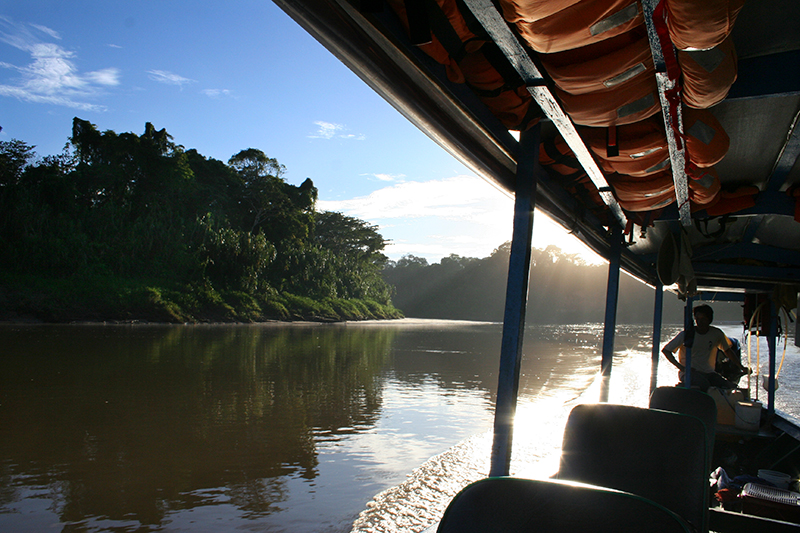 We then have 3 hours on a dugout travelling upstream along the brown waters of the Tambopata River. The jungle reaches down to the edge of the river and, apart from the odd wooden shack, we are hemmed in on both sides by greenery that looks completely impenetrable. Along the river are a number of boats that are prospecting for gold. The miners sift the river bed trying to find small amounts of precious metal and their equipment, although crude, is very effective at finding whatever gold there might be. The great downside of these operations is that they use mercury in the process and, we are told, 4 tons of it gets dumped in the Tambopata every year. People no longer eat the fish. By the time we reach our destination, Refugio Amazonias, it is late in the afternoon with a couple of hours of daylight left.
We then have 3 hours on a dugout travelling upstream along the brown waters of the Tambopata River. The jungle reaches down to the edge of the river and, apart from the odd wooden shack, we are hemmed in on both sides by greenery that looks completely impenetrable. Along the river are a number of boats that are prospecting for gold. The miners sift the river bed trying to find small amounts of precious metal and their equipment, although crude, is very effective at finding whatever gold there might be. The great downside of these operations is that they use mercury in the process and, we are told, 4 tons of it gets dumped in the Tambopata every year. People no longer eat the fish. By the time we reach our destination, Refugio Amazonias, it is late in the afternoon with a couple of hours of daylight left.
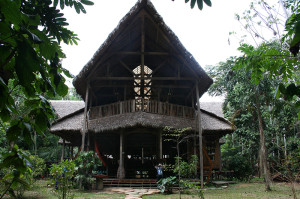 The lodge is a 10-minute walk from the river into the primary rainforest and is a very impressive building made from (sustainable) wood but pretty much has only a floor raised 5 feet off the ground and a roof. There are no walls, doors or windows with the building being fully open to the forest. It was the same story with our room which only had a partition between our neighbour and a somewhat flimsy curtain that served as the door. There was no aircon, the bed had a simple but effective mosquito net, instead of lights there were kerosene lamps and candles, the shower had only cold water (but very refreshing) and we shared our bathroom with 3 or 4 frogs. Everything else we shared with mosquitoes or other flying insects but we quickly learnt to slap on Deet (insect repellent) and ignore things buzzing around us. If you don’t, you spend the whole day imitating a helicopter.
The lodge is a 10-minute walk from the river into the primary rainforest and is a very impressive building made from (sustainable) wood but pretty much has only a floor raised 5 feet off the ground and a roof. There are no walls, doors or windows with the building being fully open to the forest. It was the same story with our room which only had a partition between our neighbour and a somewhat flimsy curtain that served as the door. There was no aircon, the bed had a simple but effective mosquito net, instead of lights there were kerosene lamps and candles, the shower had only cold water (but very refreshing) and we shared our bathroom with 3 or 4 frogs. Everything else we shared with mosquitoes or other flying insects but we quickly learnt to slap on Deet (insect repellent) and ignore things buzzing around us. If you don’t, you spend the whole day imitating a helicopter.
The routine had us up before dawn and after a quick breakfast, the morning trek begins and lasts about 4 or 5 hours until we would return about 1130. After lunch, we would be out again around 3.00pm, returning as it got dark at 6.00pm. There was usually an activity after dinner just in case anyone considered spending too much time at the bar.
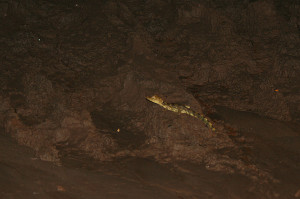 Our first night we went on the river looking for caiman, the jungle equivalent of alligators. At night they come out of the tall grass and riverside vegetation to feed and there are plenty to see from little juveniles to large (about 2 metre) ugly adults.
Our first night we went on the river looking for caiman, the jungle equivalent of alligators. At night they come out of the tall grass and riverside vegetation to feed and there are plenty to see from little juveniles to large (about 2 metre) ugly adults.
Afterwards, when we got to bed, it becomes obvious that in the jungle you are never alone. Never mind the creepy crawlies and other ‘beings’ that share your accommodation, the noise is constant. As we became more expert, thanks to the guides’ tuition, we were able to begin to identify many of the sounds as belonging to particular animals.
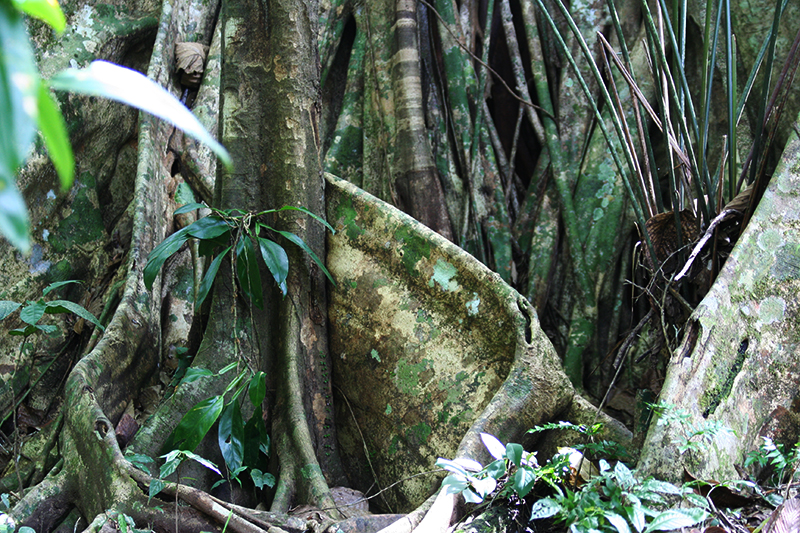 During the day, when we were walking the trails, we could hear animal and bird calls and shouts but rarely could we see who or what was making the racket. The forest is impenetrable to the eye at a distance of a few metres. This became our only real disappointment – that we did not see more wildlife. From various open areas, such as the canopy tower and the lake, we saw a number of exotic birds but we only ever heard monkeys and wild pigs. Ants, spiders, tarantulas, termites, flora and fauna we saw in shedloads but panthers, jaguars, anteaters and all the other large beats were nowhere to be seen.
During the day, when we were walking the trails, we could hear animal and bird calls and shouts but rarely could we see who or what was making the racket. The forest is impenetrable to the eye at a distance of a few metres. This became our only real disappointment – that we did not see more wildlife. From various open areas, such as the canopy tower and the lake, we saw a number of exotic birds but we only ever heard monkeys and wild pigs. Ants, spiders, tarantulas, termites, flora and fauna we saw in shedloads but panthers, jaguars, anteaters and all the other large beats were nowhere to be seen.
Debbie did contrive to step on another snake. Mammal and reptile alike both jumped out of their skin both shouting naughty words whilst Debbie did a little dance. The poor green rat snake will now think twice before having a kip alongside a trail. In fact there was a second snake of the same species close by and the guide. Patricia, thought that, as it was unusual to have two of them so close together, they were probably about to mate. Ho ho, not now they won’t, one of them will definitely have a headache!
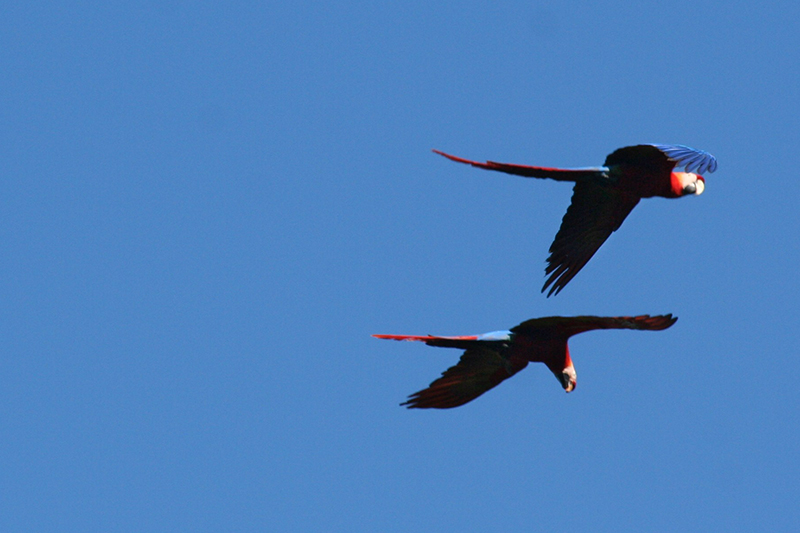 Probably our most interesting outing was to a clay lick. This is a piece of ground that is rich in antioxidants and minerals, and various animals come to feed off it in order to reduce the toxins in their bodies, McCaws are a perfect case in point. They derive their bright colours from eating toxins and they visit the clay lick on a daily basis in order to survive. They are stunning birds, so brightly coloured and unmistakable against the green backdrop of the rainforest. We sat in a hide to watch them and were rewarded with up to 6 pairs that spent two hours flying around our position. They are very cautious birds and spend a long time watching the clay lick for any sign of predators before they feed. They are also followers, with no one wishing to be the first to feed, so that all sit about in trees shouting at one another ‘after you!’. I suspect they are in reality flying chickens.
Probably our most interesting outing was to a clay lick. This is a piece of ground that is rich in antioxidants and minerals, and various animals come to feed off it in order to reduce the toxins in their bodies, McCaws are a perfect case in point. They derive their bright colours from eating toxins and they visit the clay lick on a daily basis in order to survive. They are stunning birds, so brightly coloured and unmistakable against the green backdrop of the rainforest. We sat in a hide to watch them and were rewarded with up to 6 pairs that spent two hours flying around our position. They are very cautious birds and spend a long time watching the clay lick for any sign of predators before they feed. They are also followers, with no one wishing to be the first to feed, so that all sit about in trees shouting at one another ‘after you!’. I suspect they are in reality flying chickens.
We also visited a local farm that practiced, what we were told was, sustainable farming. The traditional jungle approach to farming is to flatten everything above ground level and burn it. There are then sufficient nutrients in the ground to sustain a crop for a year. The following year, the farmer has to do the same to another bit of ground and so on for 7 years until he can return to the original area. This is called ‘slash and burn’, and does not use the soil very effectively whilst also clearing larger areas of forest than should be necessary. The sustainable method involves planting a wide variety of produce, mostly tree fruits, which do not make the ground barren. Growing fruit is all very well but it is hard to see how other crops, such as beans and maize, can be produced without using the slash and burn method.
We both enjoyed our short time in the jungle despite not seeing as much wildlife as we would have liked. We were warned from speaking to fellow travellers that we might be disappointed so, at least, our expectations were managed. In any case we’re now off on holiday, we need a break from all the travelling!

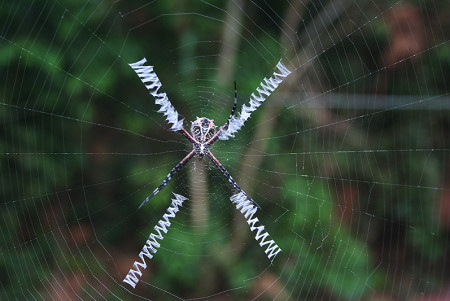
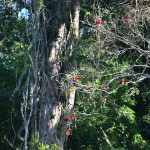
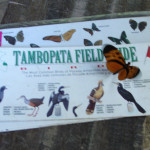
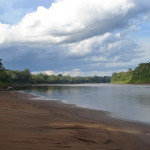
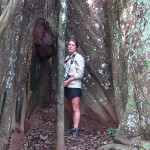
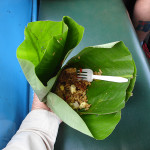
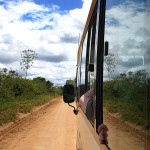
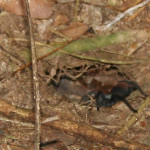
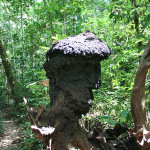
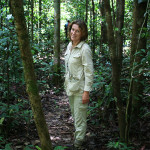
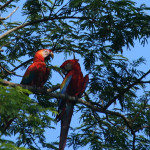
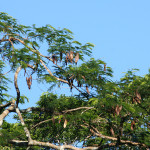
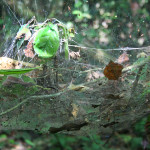
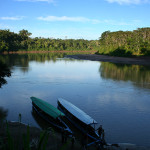
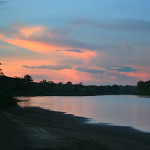
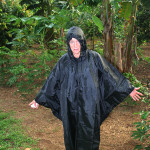
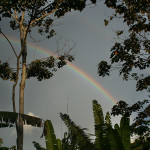
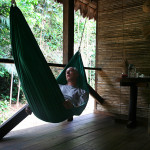
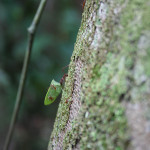
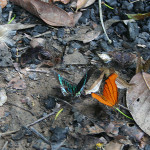
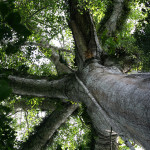
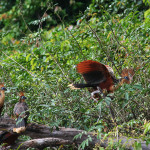
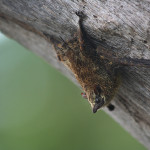
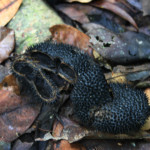
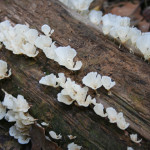
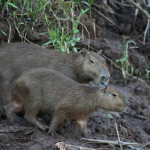

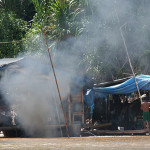
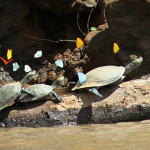
No comments yet.